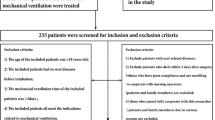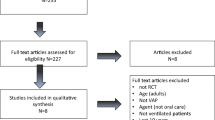Abstract
The objective is to survey the effect of evidence-based nursing (EBN) in preventing ventilator-associated pneumonia and to observe the effect, providing a reference for clinical nursing intervention. 146 patients with mechanical ventilator were included and randomly divided into control group (n = 73) and observation group (n = 73). Patients in control group received conventional nursing method, and patients in observation group received EBN according to the nursing principles. The questions were raised and the literatures were retrieved to formulate the optimum nursing strategy according to clinical experience and patient need. After nursing, morbidity of VAP in observation group was significantly lower than control group, and length of stay, length of stay in ICU, and the duration of mechanical ventilation were also significantly lower than control group; the differences were statistically significant (P < 0.05). After nursing, the physiological function, physical role, somatic pain, and mental health scores in observation group were significantly higher than control group (P < 0.05). Oral hygiene status in observation group was significantly better than control group; the difference was statistically significant (P < 0.05). After nursing, IL-1, IL-6, and TNF-α in two groups were both decreased (P < 0.05); IL-1, IL-6 and TNF-α in observation group were significantly lower than control group (P < 0.05). When patients were discharged, satisfaction degree in observation group was significantly higher than control group; the difference was statistically significant (P < 0.05). The implementation of EBN can effectively prevent the occurrence of ventilator-associated pneumonia and improve the clinical nursing quality, which is worthy of clinical application.



Similar content being viewed by others
References
Rello, J., Lode, H., Cornaglia, G., et al. (2010). A European care bundle for prevention of ventilator-associated pneumonia[J]. Intensive Care Medicine, 36(5), 773–780.
Hunter, J. D. (2006). Ventilator associated pneumonia. Postgraduate Medical Journal, 82(965), 172–178.
Rubinstein, E., Lalani, T., Corey, G. R., et al. (2011). Telavancin versus vancomycin for hospital-acquired pneumonia due to gram-positive pathogens. Clinical Infectious Diseases, 52(1), 31–40.
Sandström, B., Borglin, G., Nilsson, R., et al. (2011). Promoting the implementation of evidence-based practice: A literature review focusing on the role of nursing leadership. Worldviews on Evidence-Based Nursing, 8(4), 212–223.
Fox, S. H., Katzenschlager, R., Lim, S. Y., et al. (2011). The movement disorder society evidence-based medicine review update: Treatments for the motor symptoms of Parkinson’s disease. Movement Disorders, 26(3), 2–41.
Labeau, S. O., Van de Vyver, K., Brusselaers, N., et al. (2011). Prevention of ventilator-associated pneumonia with oral antiseptics: a systematic review and meta-analysis. The Lancet Infectious Diseases, 11(11), 845–854.
Berry, A. M., Davidson, P. M., Masters, J., et al. (2011). Effects of three approaches to standardized oral hygiene to reduce bacterial colonization and ventilator associated pneumonia in mechanically ventilated patients: a randomised control trial. International Journal of Nursing Studies, 48(6), 681–688.
Scannapieco, F. A., & Binkley, C. J. (2012). Modest reduction in risk for ventilator-associated pneumonia in critically ill patients receiving mechanical ventilation following topical oral chlorhexidine. Journal of Evidence Based Dental Practice, 12(2), 103–106.
Özçaka, Ö., Başoğlu, Ö. K., Buduneli, N., et al. (2012). Chlorhexidine decreases the risk of ventilator-associated pneumonia in intensive care unit patients: a randomized clinical trial. Journal of Periodontal Research, 47(5), 584–592.
Snyders, O., Khondowe, O., & Bell, J. (2011). Oral chlorhexidine in the prevention of ventilator-associated pneumonia in critically ill adults in the ICU: A systematic review. Southern African Journal of Critical Care, 27(2), 48–56.
Ricard, J. D., Boyer, A., & Dreyfuss, D. (2012). Humidification devices and ventilator-associated pneumonia: Current recommendations on respiratory equipment/humidification in the intensive care unit (pp. 199–207). Berlin Heidelberg: Springer.
Bouadma, L., Mourvillier, B., Deiler, V., et al. (2010). A multifaceted program to prevent ventilator-associated pneumonia: Impact on compliance with preventive measures. Critical Care Medicine, 38(3), 789–796.
Bonten, M. J. M. (2011). Ventilator-associated pneumonia: preventing the inevitable. Clinical Infectious Diseases, 52(1), 115–121.
Werarak, P., Kiratisin, P., & Thamlikitkul, V. (2010). Hospital-acquired pneumonia and ventilator-associated pneumonia in adults at Siriraj Hospital: Etiology, clinical outcomes, and impact of antimicrobial resistance. Journal of the Medical Association of Thailand, 93, 126–138.
Bassi, G. L., & Torres, A. (2011). Ventilator-associated pneumonia: Role of positioning. Current Opinion in Critical Care, 17(1), 57–63.
Mauri, T., Berra, L., Kumwilaisak, K., et al. (2010). Lateral-horizontal patient position and horizontal orientation of the endotracheal tube to prevent aspiration in adult surgical intensive care unit patients: a feasibility study. Respiratory care, 55(3), 294–302.
Morris, A. C., Hay, A. W., Swann, D. G., et al. (2011). Reducing ventilator-associated pneumonia in intensive care: Impact of implementing a care bundle. Critical Care Medicine, 39(10), 2218–2224.
Reignier, J., Mercier, E., Le Gouge, A., et al. (2013). Effect of not monitoring residual gastric volume on risk of ventilator-associated pneumonia in adults receiving mechanical ventilation and early enteral feeding: A randomized controlled trial. JAMA, 309(3), 249–256.
Scannapieco, F. A., & Binkley, C. J. (2012). Modest reduction in risk for ventilator-associated pneumonia in critically ill patients receiving mechanical ventilation following topical oral chlorhexidine. Journal of Evidence Based Dental Practice, 12(2), 103–106.
Edriss, H., Whiting, J., & Nugent, K. (2014). A ventilator-associated event in an intensive care unit patient with multiple comorbidities and prolonged mechanical ventilation. Gaziantep Medical Journal, 20(3), 277–280.
Kofteridis, D. P., Alexopoulou, C., Valachis, A., et al. (2010). Aerosolized plus intravenous colistin versus intravenous colistin alone for the treatment of ventilator-associated pneumonia: A matched case-control study. Clinical Infectious Diseases, 51(11), 1238–1244.
Rattanaumpawan, P., Lorsutthitham, J., Ungprasert, P., et al. (2010). Randomized controlled trial of nebulized colistimethate sodium as adjunctive therapy of ventilator-associated pneumonia caused by Gram-negative bacteria. Journal of Antimicrobial Chemotherapy, 65(12), 2645–2649.
Jones, R. N. (2010). Microbial etiologies of hospital-acquired bacterial pneumonia and ventilator-associated bacterial pneumonia. Clinical Infectious Diseases, 51(1), 81–87.
Ceccarelli, G., Falcone, M., Giordano, A., et al. (2013). Successful ertapenem-doripenem combination treatment of bacteremic ventilator-associated pneumonia due to colistin-resistant KPC-producing Klebsiella pneumoniae. Antimicrobial Agents and Chemotherapy, 57(6), 2900–2901.
Arnold, H. M., Sawyer, A. M., & Kollef, M. H. (2012). Use of adjunctive aerosolized antimicrobial therapy in the treatment of Pseudomonas aeruginosa and Acinetobacter baumannii ventilator-associated pneumonia. Respiratory care, 57(8), 1226–1233.
Arnold, H. M., Sawyer, A. M., & Kollef, M. H. (2012). Use of adjunctive aerosolized antimicrobial therapy in the treatment of Pseudomonas aeruginosa and Acinetobacter baumannii ventilator-associated pneumonia. Respiratory care, 57(8), 1226–1233.
Martin-Loeches, I., Nseir, S., Valles, J., et al. (2013). From ventilator-associated tracheobronchitis to ventilator-associated pneumonia. Reanimation, 22(3), 231–237.
Craven, D. E., & Hjalmarson, K. I. (2010). Ventilator-associated tracheobronchitis and pneumonia: thinking outside the box. Clinical Infectious Diseases, 51(1), 59–66.
Micik, S., Besic, N., Johnson, N., et al. (2013). Reducing risk for ventilator associated pneumonia through nursing sensitive interventions. Intensive and Critical Care Nursing, 29(5), 261–265.
Blot, S. I., Serra, M. L., Koulenti, D., et al. (2011). Patient to nurse ratio and risk of ventilator-associated pneumonia in critically ill patients. American Journal of Critical Care, 20(1), 1–9.
Author information
Authors and Affiliations
Corresponding author
Rights and permissions
About this article
Cite this article
Meng, K., Li, Y., Li, S. et al. The Survey on Implementation of Evidence-Based Nursing in Preventing Ventilator-Associated Pneumonia and the Effect Observation. Cell Biochem Biophys 71, 375–381 (2015). https://doi.org/10.1007/s12013-014-0208-x
Published:
Issue Date:
DOI: https://doi.org/10.1007/s12013-014-0208-x




